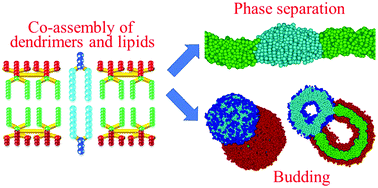Branching pattern effect and co-assembly with lipids of amphiphilic Janus dendrimersomes
Abstract
The influence of the branching patterns on the membrane properties of Janus dendrimers in water has been investigated by dissipative particle dynamics simulations. The hydrophobic fluorinated dendron (RF) contains three types of branching patterns, including 3,4-, 3,5-, and 3,4,5-RF. Consistent with experimental results, the hydrophobic layer thickness (HB) follows the order: 3,5-RF < 3,4-RF < 3,4,5-RF, which can be explained by the extent of interdigitation (Δh): 3,5-RF > 3,4-RF > 3,4,5-RF. Moreover, the 3,4,5-RF membrane shows the highest stretching modulus (KA) and the lowest lateral diffusivity (D). The 3,5-RF membrane is similar to the 3,4-RF membrane but exhibits a higher KA and smaller D. For the nano-sized dendrimersome, its bilayer thickness is less than that of the planar membrane due to its larger extent of interdigitation. The co-assembly of dendrimersomes with lipids has been studied as well. The thickness and the extent of interdigitation of the lipid-rich domain for the hybrid membrane are significantly affected by the lipid concentration (ϕl) and the branching patterns. As ϕl increases, the thickness of the lipid-rich domain grows corresponding to the decrease of interdigitation of the lipid-rich domain.

- This article is part of the themed collection: 2018 PCCP HOT Articles


 Please wait while we load your content...
Please wait while we load your content...